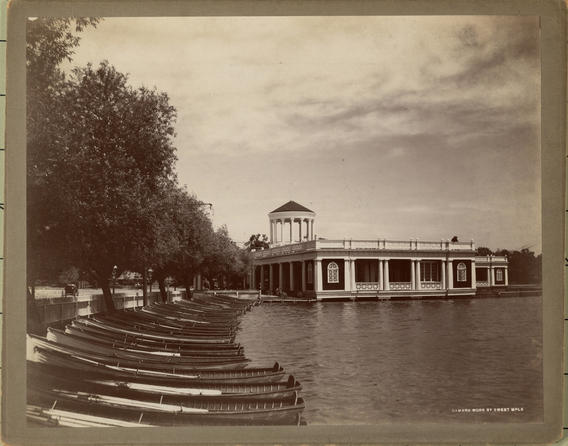
Race War in Linden Hills
In the very first days of 1910, a group of white Linden Hills residents declared that "a strong attempt will be made to oust" the "negro families living in the vicinity" of their homes.
That year there were 13 African Americans in the southwest corner of the city adjacent to Lake Harriet. Thirty years later, they were all gone.
So--what happened? How did Linden Hills become an all white enclave? Much of the neighborhood was platted before racial covenants came into use in 1910. African Americans already owned property there. Why did these established residents give up their homes and leave this part of the city?
The historical record reveals a coordinated and sometimes vicious campaign to push these families out.
Since the 1880s, real estate developers like Thomas Lowry and Edmund Walton had imagined this boggy quarter as an exclusive suburb. Lake Harriet was a magnet, especially after the park board constructed a "pleasure pavilion" on its shores that served as a concert venue, restaurant and bathhouse for swimmers. But residential development remained slow and uneven for decades.
Then, in the first decade of the twentieth century, the tempo of growth accelerated. The streetcar network was extended in the neighborhood. "The loop" shopping district at 43rd and Upton expanded. Residents had only to walk a few blocks to buy groceries, hardware and clothing. The neighborhood acquired pharmacies and a post office.
But the biggest attraction remained the lake. Pleasure seekers were disappointed when the Lake Harriet "pleasure pavilion" was destroyed in a devastating fire. But in 1904, the Minneapolis Park Board replaced the facility with an extravagant Classic Revival summer palace.

Lake Harriet Concert Pavilion, 1904. Image credit: Minneapolis Collection, Hennepin County Library, Minneapolis, MN.
The new summer mecca included a concert venue built to showcase performances by the Minneapolis Symphony Orchestra. Thousands could listen to music or watch fireworks displays from the rooftop deck. Or they could walk downstairs to enjoy a "dining room, popcorn machines, taffy machines, confectionaries, restrooms, and a comfortable wide promenade over the water," according to Harlan Strong, who grew up in the neighborhood during those years. The lower level had changing rooms and steps that led into a fenced swimming area. Adjacent to the pavilion was a pony track for children. Ostriches roamed the grounds.
This was paradise. But some white residents saw trouble.
This group feared that small group of long-time residents could endanger the neighborhood's increasingly upscale reputation. They resolved to rid themselves of their African-American neighbors.
In 1909, neighbors became enraged at the news that the Reverend William S. Malone had made an agreement to buy a bungalow at 4441 Zenith Avenue from Marie Canfield. Canfield was in conflict with her neighbors, who had testified against her in a court case involving the New England Furniture Company. She had accused the company of selling her a faulty stove with a gas leak. Her neighbors declared that she was a frequent user of opiates. She lost her case. Neighbors said that she then listed her property "for sale to negroes only."
Canfield denied this account. She asserted that she had never used drugs. And she told the newspaper that she never advertised her property in this way. Instead, she explained that “the real estate market was dull,” so she agreed to sell it to the “first person who was willing to take it.” That person was William S. Malone, an African-American minister with an outreach mission in downtown Minneapolis.
News of the agreement roiled the neighborhood. Over 100 neighbors gathered for an "indignation meeting" across the street in December 1909. Some threatened to burn the house rather than see Malone take possession.
Canfield scoffed. She told the newspaper that another negro family lived within a block of her bungalow and still others lived in the area so “the present furor seems a trifle hysterical and forced.”
But neighbors hired an attorney to fight the transaction. And when the Hennepin County Sheriff seized the property to settle Canfield's court fine, they pooled their funds to keep the home out of the hands of the African-American minister.
And once this group had mobilized against what the Minneapolis Tribune called "the establishment of a 'darktown' in their midst," they intensified what the newspaper called their "race war."
At the beginning of 1910, they turned their attention to Mary V. Myrick, who owned a small house at 4601 Zenith Avenue South. In 1903, the widow Myrick had bought a lot six blocks from her daughter and son-in-law, Moses and Mary Burkes. She paid cash and built a modest house, which she shared with her sister, niece and several grandchildren. She supported her family by doing domestic work for other families nearby.
According to the Minneapolis Tribune, "the home of the negress is said to be a small shack, worth practically nothing." But Myrick refused to sell it to her white neighbors. According to the newspaper, she was holding "out for a tremendous price for her property." She demanded no less than $4500 to relinquish the property that housed her extended family.
Neighbors dismissed her demands as outrageous. "As an effort to force her to move, the neighbors and those in the vicinity will refuse to give her any more work, believing she will leave the neighborhood," the newspaper reported.
Myrick resisted this economic pressure and held on to the property until 1918. No doubt her family pooled all of their resources to keep a roof overhead.
Neighborhood activists declared that they would not rest until they had expelled Myrick and all of the other African Americans who had made homes nearby.
The Myrick clan remained steadfast for some years. Myrick's niece Daisy even bought another house nearby after she was married. But ultimately, the self-appointed foot soldiers of the Linden Hills "race war" were victorious.
By 1940, the neighborhood was entirely white.